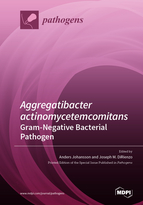Aggregatibacter actinomycetemcomitans—Gram-Negative Bacterial Pathogen
A special issue of Pathogens (ISSN 2076-0817). This special issue belongs to the section "Bacterial Pathogens".
Deadline for manuscript submissions: closed (31 January 2020) | Viewed by 52060
Special Issue Editors
Interests: periodontal infection; Aggregatibacter actinomycetemcomitans; virulence mechanisms; pro-inflammatory response
Special Issues, Collections and Topics in MDPI journals
Special Issue Information
Dear Colleagues,
Aggregatibacter actinomycetemcomitans, a member of the Gram-negative taxonomic family Pasteurellaceae, has attracted considerable attention as a potentially important pathogen in specific forms of periodontal disease and has earned a reputation as a member of the HACEK group of bacteria associated with some cases of infective endocarditis. The bacterium has acquired an impressive virulence-related armamentarium, including two well-characterized cytotoxins, exoenzymes, adhesins, and signaling molecules that promote its colonization and perturbation of the tissues, structural cells, and inflammatory cells of the human oral cavity. The focus of this Special Issue is on the properties and activities of A. actinomycetemcomitans that promote its function as an infectious agent, that is, its ability to target specific host populations, and define its interactions with specific mucosal tissues and cells. The objective is to present a complete picture of the participation of this bacterium in disease by presenting both in vitro and in vivo experimental and clinical studies. A comprehensive view of the contribution of this bacterium to mechanisms of infection and disease should also provide a basis for the development of new control strategies that move beyond the classical antibiotics.
Assoc. Prof. Anders Johansson
Prof. Joseph M. DiRienzo
Guest Editor
Manuscript Submission Information
Manuscripts should be submitted online at www.mdpi.com by registering and logging in to this website. Once you are registered, click here to go to the submission form. Manuscripts can be submitted until the deadline. All submissions that pass pre-check are peer-reviewed. Accepted papers will be published continuously in the journal (as soon as accepted) and will be listed together on the special issue website. Research articles, review articles as well as short communications are invited. For planned papers, a title and short abstract (about 100 words) can be sent to the Editorial Office for announcement on this website.
Submitted manuscripts should not have been published previously, nor be under consideration for publication elsewhere (except conference proceedings papers). All manuscripts are thoroughly refereed through a single-blind peer-review process. A guide for authors and other relevant information for submission of manuscripts is available on the Instructions for Authors page. Pathogens is an international peer-reviewed open access monthly journal published by MDPI.
Please visit the Instructions for Authors page before submitting a manuscript. The Article Processing Charge (APC) for publication in this open access journal is 2700 CHF (Swiss Francs). Submitted papers should be well formatted and use good English. Authors may use MDPI's English editing service prior to publication or during author revisions.
Keywords
- Aggregatibacteria actinomycetemcomitans
- leukotoxin
- cytolethal distending toxin
- epidemiology
- periodontal pathogen
- collagenase
- biofilm
- HACEK
- systemic disease








